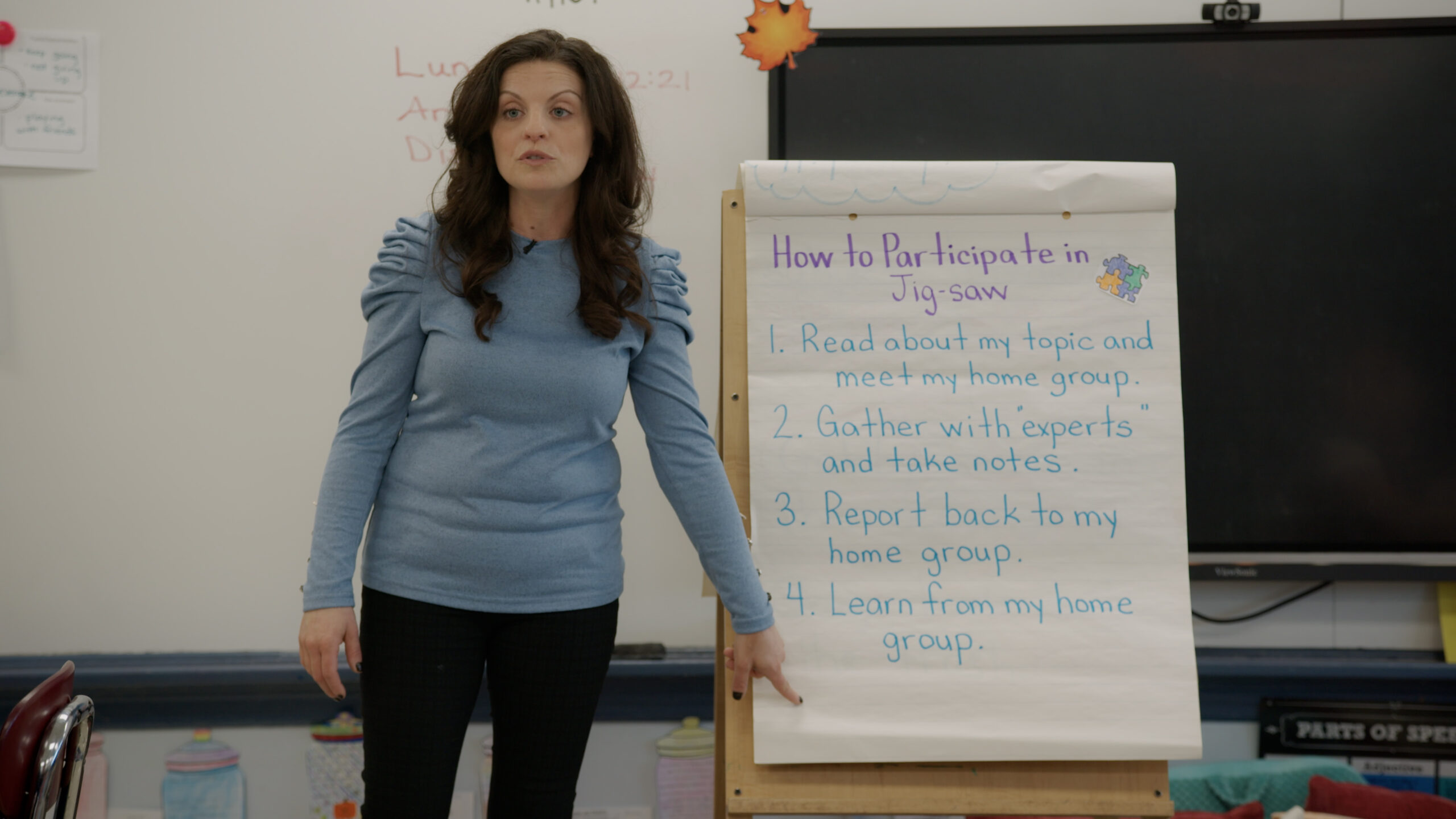Create topic sentences to Find the Main Idea
Overview
The teacher defines and identifies a topic sentence and supporting details while modeling with a familiar text in a targeted, small group format. As the details of the story change, the students turn and talk to discuss a topic sentence that describes the paragraph’s main idea. The teacher then connects the reading to writing as the group writes a new topic sentence together while practicing decoding and phoneme/grapheme connection.
Key Take-aways
•Infuse opportunities for writing during literacy instruction to support building content knowledge and stamina.
•Apply this strategy using nonfiction texts across grade levels and subject areas to support comprehension.
•Read a section of text, ask students to discuss possible topic sentences with a partner, and write their topic sentences together.
Transcript
Dr. Ken Kunz: In this video, Mrs. Kapinos is leading us through a captivating exploration of comprehension strategies in the classroom. Watch closely as she models the process with a chosen text, reading alongside our eager students and unraveling the intricacies of topic sentences. Mrs. Kapinos reads aloud a passage from the sandwich swap, providing a hands-on model for the students before they delve into the art of partner writing.
Teacher: Okay, ready? Selma and Lily were best friends at school. That would be our topic sentence. Okay.
Student(s): Yes.
Teacher: After that, it’s going to tell us all the things that we’re going to be reading about of how they were best friends. All right. We’re going to keep reading to see how are they best friends at school. This was our topic sentence. Now all of our details are going to follow. Alright, so let’s take a look. They drew pictures together. Does that show that they were best friends?
Student(s): Yep.
Teacher: They played on the swings together.
Student(s): Yeah, yeah, yeah. They jumped roped together.
Teacher: Yep. Yep. Yeah. And they ate their lunches together.
Student(s): See that dog-cat thing? Yeah. Yeah. I told you there was a dog.
Teacher: But just what they ate at lunch was a little different. Lily ate a peanut butter and jelly sandwich every day for lunch, and Selma ate a hummus and pita sandwich every day for lunch. And then, although Selma never said it out loud, she thought Lily’s sandwich looked strange and gross. She felt awful that her friend had to eat that gooey peanut butter paste every day. Ew. Yuck. Remember our topic sentence tells us what we’re going to be reading about what’s coming next. So I want you to turn and talk to your partner and you’re going to talk about what the new topic sentence might be.
Student(s): Maybe they won’t be friends again.
Student(s): They’re going to still be best friends.
Teacher: They’re going to still be best friends. After reading this page?
Teacher: So, what did you think your new topic sentence was going to be?
Student(s): Um, they won’t be friends and then they’ll try, um, each other’s sandwiches and then they’ll be friends again.
Teacher: Why did you think that they’re not going to be friends anymore?
Student(s): Because they’re, I think, I think they’re going to be fighting because they don’t like each other’s sandwich.
Teacher: They don’t like each other’s sandwiches. Let’s take a look. We’re going to write down our new topic sentence. I think I like this. I think this one really kind of made more sense because they were saying, Ew, Yuck.
Student(s): Yuck.
Teacher: Right. They didn’t like each other’s sandwiches. Alright, so we’re going to write down our topic sentence. I’m going to write it down first, and then you are going to copy it into your notebook. Okay. I want you to help me sound some words out that we’re going to write. Okay. So, what are we writing?
Student(s): About Selma and Lily
Teacher: What’s a good sentence we can write down?
Student(s): They won’t be friends, and then they don’t like each other’s sandwiches, and maybe they’ll try each other’s sandwiches
Teacher: So they don’t like each other’s sandwiches. Right. Okay. So, we’re going to write down our new topic sentence. Like, how do we spell like? David, how do we spell like? /l/
Student(s): L, I, a K, and a E
Teacher: What’s that E?
Student(s): A magic E.
Teacher: Magic E. Lily and Selma do not like..
Student(s): Each others.
Teacher: Each.
Student(s): Each.
Teacher: Each.
Teacher: What does it begin with? /e/. Two vowels.
Student(s): /ch/. Ch
Teacher: Very good.
Student(s): Each.
Teacher: Other.
Student(s): Other.
Teacher: That’s going to be the same word. That’s one word.
Student(s): Why do I make mistakes?
Teacher: It’s okay. We all make mistakes, right? It’s okay. Good.
Student(s): Lily and Selma do not like each other’s sandwiches.
Teacher: Can that be our new topic sentence?
Student(s): Yes. Yes.
Teacher: Okay. Very good. Let’s reread our topic sentence one more time. Read it with me. Ready?
Student(s): Lily and Selma do not like each other’s sandwiches.
Teacher: Beautiful.
Dr. Ken Kunz: In the upper grades, lengthier texts with combined comprehension strategies can be used for writing. Students could partner read and come up with their own topic sentences. You can see that in the foundational lesson first grade, students are prone to making predictions but also have to be explicitly taught to notice key details of importance in the moment.


